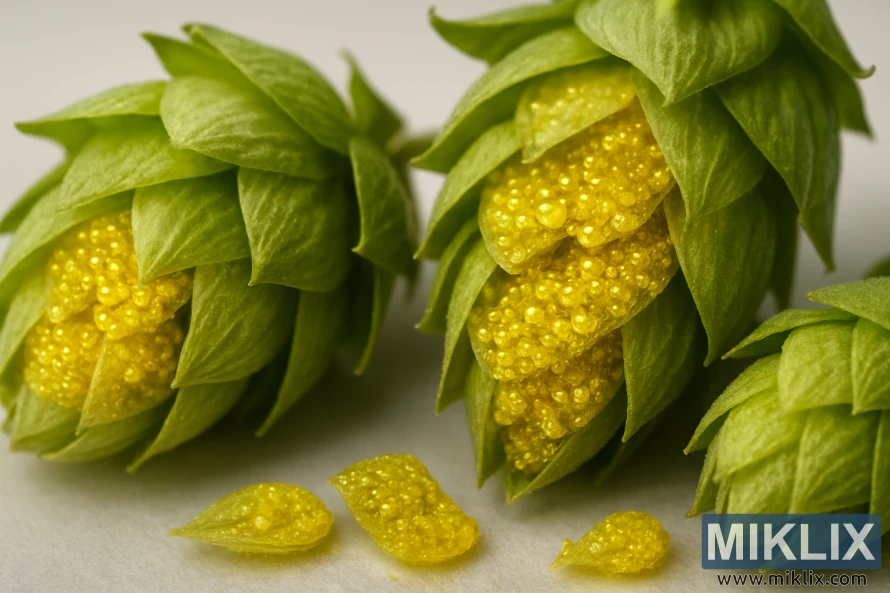Image: Macro View of Landhopfen Lupulin Glands
Published: September 28, 2025 at 10:26:13 PM UTC
A detailed macro photo shows Landhopfen hop cones with golden lupulin glands, highlighting their alpha acids vital to brewing bitterness and aroma.
This high-resolution, landscape-oriented macro photograph captures an extraordinary close-up view of Landhopfen alpha acids — the potent bittering agents found in hop cones used extensively in the brewing industry. The image is composed with a shallow depth of field, focusing precisely on the glistening yellow lupulin glands, the resinous structures nestled within the overlapping green bracts of the hop cone. These glands are rich in alpha acids and essential oils that contribute bitterness, flavor, and aroma to beer, making them a crucial component in the brewing process.
Three hop cones are arranged across a clean, neutral background — a soft, pale surface that eliminates distractions and allows the botanical intricacies to take visual precedence. The lighting is diffuse and gentle, free from harsh shadows, which enhances the natural textures and translucency of the plant material without creating glare. This lighting choice reinforces a scientific, clinical aesthetic, as though the subject is under examination in a laboratory environment.
The most prominent hop cone is located just right of center. Its bracts are peeled slightly open, revealing a thick, glimmering cluster of lupulin glands. These glands appear as compact globules, tightly packed and coated in a golden-yellow resin that sparkles subtly under the light. The resin has a tacky, almost crystalline appearance, conveying a sense of sticky richness and potency. The surface tension of the resin droplets is finely captured, each one distinct and semi-translucent, suggesting the density and viscosity of the essential oils and bittering compounds contained within.
To the left and right of the main cone, two others are visible — slightly more closed but still revealing golden glimpses of the lupulin beneath their green petal-like layers. These side cones serve to contextualize the subject matter, reinforcing the natural form and anatomy of hops, while also framing the image compositionally.
In the foreground, several lupulin-covered bract fragments have been meticulously placed on the surface. These fragments provide an anatomical cross-section of sorts — as though a sample has been extracted and examined more closely. Their presence furthers the scientific feel of the photo, suggesting a study or inspection of the plant’s chemical properties.
The textures throughout the image are hyper-realistic. The green bracts show delicate veins and fine surface hairs, while the yellow glands are moist, bulbous, and alive with depth. The bokeh created by the shallow depth of field ensures that the focus remains on the lupulin glands, while the rest of the hop cone fades softly into a pleasant blur.
This photograph communicates more than just botanical beauty — it encapsulates the essence of technical precision, ingredient purity, and brewing science. It celebrates the microscopic, functional marvel at the heart of every pint of beer — the lupulin gland — and does so with an eye for detail that would satisfy both botanists and brewmasters alike. The overall mood of the image is deliberate, clean, and focused — a perfect blend of scientific inquiry and visual art.
The image is related to: Hops in Beer Brewing: Landhopfen

